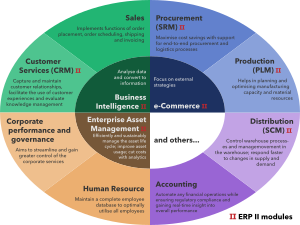
Back تخطيط موارد المؤسسة Arabic ERP BAR Планиране на ресурсите на предприятието Bulgarian Planificació de recursos empresarials Catalan Plánování podnikových zdrojů Czech Enterprise resource planning Danish Enterprise-Resource-Planning German Σύστημα ενδοεπιχειρησιακού σχεδιασμού Greek Sistema de planificación de recursos empresariales Spanish ERP (tarkvara) Estonian

Enterprise resource planning (ERP) is the integrated management of main business processes, often in real time and mediated by software and technology. ERP is usually referred to as a category of business management software—typically a suite of integrated applications—that an organization can use to collect, store, manage and interpret data from many business activities. ERP systems can be local-based or cloud-based. Cloud-based applications have grown in recent years due to the increased efficiencies arising from information being readily available from any location with Internet access.
ERP provides an integrated and continuously updated view of the core business processes using common databases maintained by a database management system. ERP systems track business resources—cash, raw materials, production capacity—and the status of business commitments: orders, purchase orders, and payroll. The applications that make up the system share data across various departments (manufacturing, purchasing, sales, accounting, etc.) that provide the data.[1] ERP facilitates information flow between all business functions and manages connections to outside stakeholders.[2]
According to Gartner, the global ERP market size is estimated at $35 billion in 2021.[3][4] Though early ERP systems focused on large enterprises, smaller enterprises increasingly use ERP systems.[5]
The ERP system integrates varied organizational systems and facilitates error-free transactions and production, thereby enhancing the organization's efficiency. However, developing an ERP system differs from traditional system development.[6] ERP systems run on a variety of computer hardware and network configurations, typically using a database as an information repository.[7]
- ^ Almajali, Dmaithan (2016). "Antecedents of ERP systems implementation success: a study on Jordanian healthcare sector". Journal of Enterprise Information Management. 29 (4): 549–565. doi:10.1108/JEIM-03-2015-0024.
- ^ Radovilsky, Zinovy (2004). Bidgoli, Hossein (ed.). The Internet Encyclopedia, Volume 1. John Wiley & Sons, Inc. p. 707. ISBN 9780471222026.
- ^ Wilson, Deborah (19 April 2019). ""The ERP Software Market: $35 billion+, 40 years in the making, but still growing nicely!" by Chris Pang". Blogs.gartner.com. Retrieved 24 July 2022.
- ^ Louis Columbus. "Predicting The Future Of Services-Centric ERP". Forbes. Retrieved 24 July 2022.
- ^ Rubina Adam, Paula Kotze, Alta van der Merwe. 2011. "Acceptance of enterprise resource planning systems by small manufacturing Enterprises". In: Proceedings of the 13th International Conference on Enterprise Information Systems, edited by Runtong Zhang, José Cordeiro, Xuewei Li, Zhenji Zhang and Juliang Zhang, SciTePress, p. 229-238.
- ^ Shaul, L.; Tauber, D. (2012). "CSFs along ERP life-cycle in SMEs: a field study". Industrial Management & Data Systems. 112 (3): 360–384. doi:10.1108/02635571211210031.
- ^ Khosrow–Puor, Mehdi (2006). Emerging Trends and Challenges in Information Technology Management. Idea Group, Inc. p. 865.